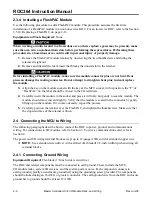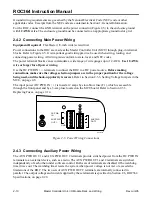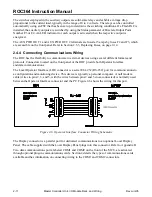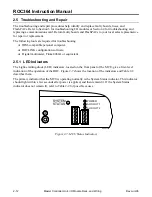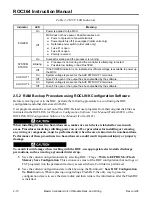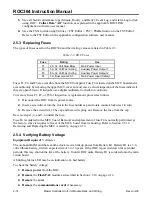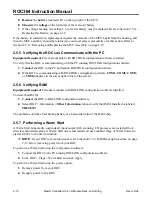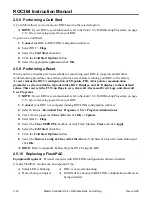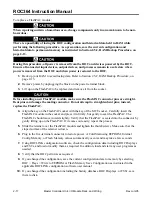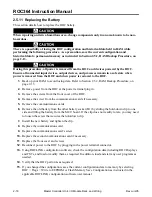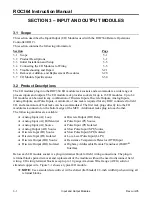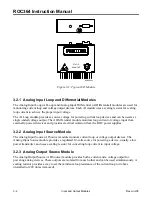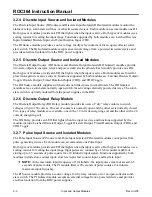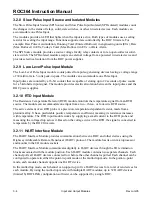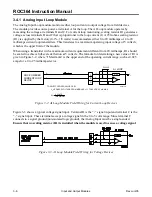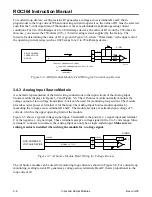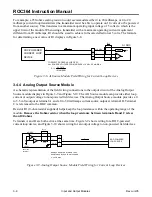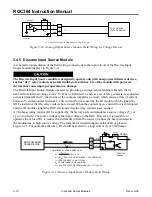
ROC364 Instruction Manual
3-3
Input and Output Modules
Rev Jun/05
3.2.4 Discrete Input Source and Isolated Modules
The Discrete Input Source (DI Source) and Discrete Input Isolated (DI Isolated) modules monitor the
status of relays, solid-state switches, or other two-state devices. Each module can accommodate one DI.
Both types of modules provide an LED that lights when the input is active. Both types of modules use a
scaling resistor for scaling the input range. Functions supported by both modules are: Latched Discrete
Input, Standard Discrete Input, and Time-Duration Input (TDI).
The DI Source module provides a source voltage for dry relay contacts or for an open-collector solid-
state switch. The DI Isolated module accepts an external voltage from a powered two-state device and
provides electrical isolation from the ROC power supplies.
3.2.5 Discrete Output Source and Isolated Modules
The Discrete Output Source (DO Source) and Discrete Output Isolated (DO Isolated) modules provide
two-state outputs to energize relays and power small electrical loads. Each module provides one DO.
Both types of modules provide an LED that lights when the input is active. Both modules are fused for
protection against excessive current. Functions supported by both modules are: Latched Discrete Output,
Toggle Discrete Output, Timed Duration Output (TDO), and TDO Toggle.
The DO Source module supplies switched current-limited power to small loads. The DO Isolated
module acts as a solid-state normally-open switch for activating externally powered devices. The solid-
state switch is optically isolated from the power supplies in the ROC.
3.2.6 Discrete Output Relay Module
The Discrete Output Relay (DO Relay) module provides two sets of “dry” relay contacts to switch
voltages of up to 250 volts ac. One set of contacts is normally open and the other set is normally closed.
Two types of relay modules are available, one with a 12 volts dc energizing coil and the other with a 24
volts dc energizing coil.
The DO Relay provides an LED that lights when the input is active and functions supported by the
module include: Latched Discrete Output, Toggle Discrete Output, Timed Duration Output (TDO), and
TDO Toggle.
3.2.7 Pulse Input Source and Isolated Modules
The Pulse Input Source (PI Source) and Pulse Input Isolated (PI Isolated) modules count pulses from
pulse-generating devices. Each module can accommodate one Pulse Input.
Both types of modules provide an LED that lights when the input is active. Both types of modules use a
scaling resistor for scaling the input range. Input pulses are counted by a 16-bit counter capable of
storing up to 6.5 seconds of pulse counts for a 10 kilohertz input signal. Functions supported by both
modules include slow-counter input, slow rate input, fast counter input, and fast rate input.
NOTE:
At the maximum input frequency of 10 kilohertz, the input pulses must not exceed 6.5
seconds of pulse counts. The PI module limit is 20 seconds of pulse counts at 3 kilohertz
maximum input frequency.
The PI Source module provides a source voltage for dry relay contacts or for an open-collector solid-
state switch. The PI Isolated module accepts an external voltage from a powered device and provides
electrical isolation from the ROC power supplies.

